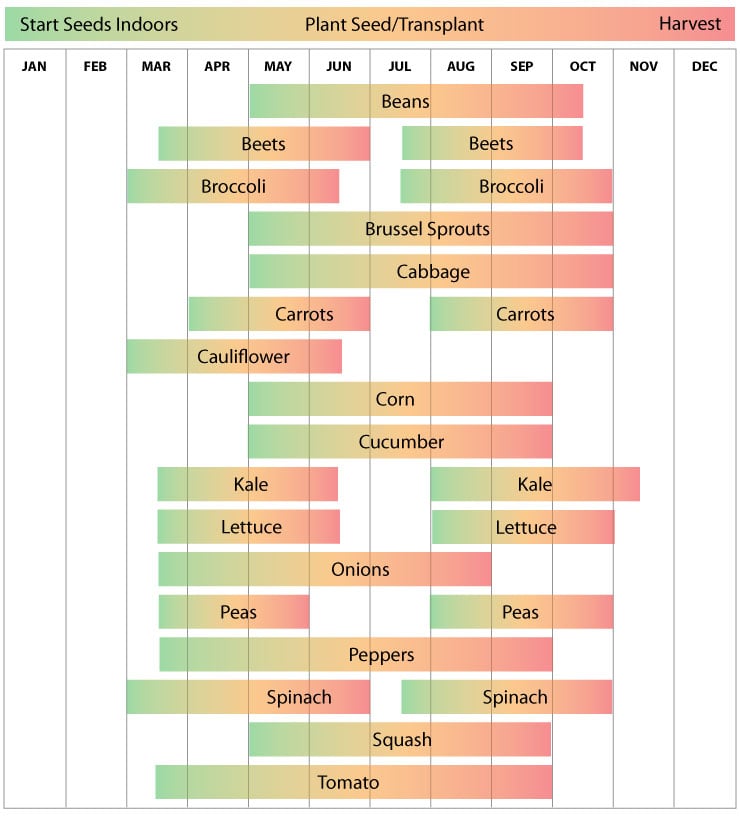Discovering the Allure of Sunflowers and the Importance of Timing
Sunflowers, with their towering stalks and vibrant yellow faces, bring a touch of summer joy to any garden. Many in Indiana find delight in growing these cheerful blooms, both for their beauty and the seeds they provide. Successfully cultivating sunflowers depends greatly on proper timing. The moment when to plant sunflowers in Indiana significantly affects their entire lifecycle. Planting too early or too late can impede germination. It can also stunt growth, and diminish the quantity and quality of blooms. The correct planting time promotes strong, healthy plants. Optimal timing will ensure vibrant flowers and a bountiful harvest.
Understanding when to plant sunflowers in Indiana is paramount. The timing is not just a date on the calendar. It is a consideration of environmental conditions. Soil temperatures and the last frost date greatly influence the success of sunflower cultivation. Planting before the soil warms can lead to seed rot. Planting too late can reduce the growing season. This will result in smaller plants and fewer blooms. Knowing when to plant sunflowers in Indiana involves careful observation and strategic timing. This ensures your sunflowers flourish in the Indiana climate. A little preparation can result in a beautiful display of these amazing flowers.
How to Determine the Best Planting Time for Sunflowers in Indiana
Determining the ideal time for planting sunflowers in Indiana requires a careful approach. It’s not simply about picking a date on the calendar. Understanding soil temperature is crucial for successful sunflower growth. Sunflowers thrive when the soil temperature reaches at least 60°F (15°C). This warmth is vital for seed germination and healthy root development. Planting too early in cold soil can lead to poor germination and stunted growth. The average last frost date in Indiana is a key factor to consider. This date varies depending on the specific region within Indiana. Generally, it falls between late April and mid-May. Planting after the last frost eliminates the risk of frost damage to young seedlings. Gardeners should look for soil temperatures that consistently stay above 60°F for the best results. Checking the weather forecast for predicted temperature trends is a good practice. These environmental conditions are more important than a calendar date when deciding when to plant sunflowers in Indiana.
The timeframe for planting sunflowers in Indiana typically spans from late May to early July. This range allows for the necessary soil warmth and reduces the risk of frost. However, it is essential to monitor the actual soil temperature and weather conditions each year. It’s recommended to plant when the soil is consistently warm. This often means several days after the last frost date. Observing the soil is key. The soil should be easy to work, and not waterlogged or frozen. When determining when to plant sunflowers in Indiana, it is important to consider these factors and tailor the planting time to the specific conditions of the year and region.
Remember, patience is key. Do not plant if the soil is not warm enough. Use a soil thermometer to verify the temperature. Proper timing of when to plant sunflowers in Indiana will contribute significantly to their overall health and blooming potential. By carefully considering soil temperature and the last frost date, you can ensure a successful sunflower growing season. This will allow you to enjoy these beautiful flowers throughout the summer. This approach will lead to healthier plants and more abundant blooms.
The Impact of Indiana’s Climate on Sunflower Growth Cycles
Indiana’s climate significantly influences when to plant sunflowers in Indiana for optimal growth. The state experiences distinct spring and summer seasons, each presenting unique challenges and opportunities for sunflower cultivation. Spring can be unpredictable, with fluctuating temperatures and occasional late frosts. These late frosts pose a significant risk to young sunflower seedlings, delaying planting until after the average last frost date is crucial for successful germination and establishment. Understanding this is key to knowing when to plant sunflowers in Indiana. Summer, however, generally provides ample warmth and sunlight, ideal for sunflower growth and maturation. The length of the growing season, from the last frost to the first significant frost, determines the types of sunflowers that thrive in different regions of Indiana. Therefore, selecting varieties suited to Indiana’s specific microclimates is crucial for maximizing yield and bloom. When deciding when to plant sunflowers in Indiana, one should carefully consider these seasonal variations.
Knowing when to plant sunflowers in Indiana also involves understanding the impact of rainfall and temperature patterns. Consistent moisture is important for germination and early growth stages. However, excessive rainfall can lead to fungal diseases, hindering growth. Conversely, extended periods of drought can stress plants, impacting their overall health and flower production. Therefore, monitoring weather forecasts and soil moisture levels provides valuable insights into the optimal planting window for sunflowers in Indiana. It’s important to consider these variables when determining when to plant sunflowers in Indiana to maximize your chances of a successful harvest.
The varying soil conditions across Indiana also play a crucial role in determining when to plant sunflowers in Indiana. Soil temperature is a significant factor affecting seed germination. Sunflowers require warm soil temperatures for optimal germination and early growth. Well-drained soil is essential to prevent waterlogging, which can lead to root rot and other diseases. Therefore, checking soil temperature and ensuring proper drainage are important considerations when determining when to plant sunflowers in Indiana. By understanding the specific climatic conditions and soil characteristics of your area within Indiana, you can accurately determine when to plant sunflowers in Indiana for a bountiful harvest. This precise timing maximizes the chances of healthy, vibrant sunflower growth and minimizes the risk of environmental setbacks.
Recognizing the Signs: When to Prepare Your Sunflower Patch
Transitioning from general timing advice, it’s crucial to recognize specific signals that indicate the right moment to prepare your sunflower patch. It’s not just about the calendar date, but more about understanding the environment. One key indicator is a consistent warming trend. Observe the weather patterns, looking for a period where temperatures begin to rise steadily. It is vital to ensure the soil is workable before beginning any planting activity. Avoid preparing the ground when it is too wet or frozen. Soil that is too wet can compact, hindering root development, while frozen soil will be impossible to work. Check to see if the soil crumbles easily when handled. This indicates it’s ready to be tilled or turned over for planting. Consider the local weather forecasts as these will be beneficial for determining when to plant sunflowers in Indiana. Take time to prepare the soil by loosening it and removing any large clumps or rocks.
Soil preparation techniques are an important step in ensuring healthy sunflower growth. If your soil is heavy clay or sandy, consider adding amendments to improve its structure and fertility. Composting is an effective technique to enrich your garden soil, improving water retention in sandy soil, and improving drainage in clay soil. You may also add other organic materials to enrich the soil with beneficial nutrients. By testing your soil’s pH, you can determine if you need to add any specific nutrients. Sunflowers prefer slightly acidic to neutral soil, so making necessary adjustments will promote better growth. Proper soil preparation greatly enhances the chances of successful germination and robust plant development. Remember, that when to plant sunflowers in Indiana, is also about ensuring that the soil is ready to nurture them. Take the time to observe these signs and prepare the site well before sowing any seeds. A well-prepared patch will allow you to plant sunflowers in Indiana with higher success rates. This includes ensuring the soil is at the correct temperature and texture.
Selecting the Right Sunflower Variety for Indiana’s Gardeners
Choosing the appropriate sunflower variety is essential for successful cultivation in Indiana. Sunflowers are not all the same; they differ significantly in size, days to maturity, and tolerance to varying environmental conditions. Therefore, understanding these variations is key to determining when to plant sunflowers in Indiana. Some varieties are better suited to the specific climate and growing season of the state. For instance, smaller, quicker-maturing varieties can be ideal for areas with shorter growing seasons. On the other hand, taller, slower-maturing types might be better suited for gardeners with longer, warmer periods available for growth. A thoughtful selection can influence the overall success and enjoyment of growing sunflowers.
The size of the sunflower is a primary factor to consider. Some varieties, like ‘Mammoth,’ can reach towering heights, while others, such as ‘Sunspot,’ remain much more compact. Days to maturity is another critical element. Some sunflowers will bloom in 60-70 days, while others take closer to 100 days. This difference impacts when to plant sunflowers in Indiana, especially if you’re aiming for a specific bloom time or want to harvest seeds before the first frost. Environmental tolerances also vary; some sunflowers are more drought-tolerant, while others might be more resistant to certain diseases. By carefully considering these factors, gardeners can choose a variety that is well-suited to the unique characteristics of Indiana’s climate and growing conditions.
For Indiana gardens, a couple of varieties often perform quite well. ‘Russian Mammoth’ is a popular choice, known for its large heads and abundant seed production. It’s a tall variety, but the seeds are ideal for roasting and enjoying. Another excellent option is ‘Lemon Queen,’ which produces multiple flower heads on each plant. It’s a moderate-sized variety that’s great for adding beauty and color. When determining when to plant sunflowers in Indiana, these varieties can offer a good starting point. They both have demonstrated resilience and adaptability to the region’s conditions. Selecting varieties with these qualities significantly increases the chances of a healthy and rewarding sunflower harvest. Choosing the right type will enable better planning and provide a more fruitful gardening experience.
Nurturing Young Sunflowers: Early Care for Optimal Growth
The initial days and weeks following germination are crucial for sunflower development. Proper care during this phase ensures strong, healthy plants. Once seedlings emerge and display their first true leaves, attention to detail becomes paramount. Providing consistent moisture is essential, but avoid overwatering, which can lead to root rot. Water deeply, allowing the soil to dry slightly between waterings. This promotes strong root growth. When to plant sunflowers in Indiana is carefully considered, and so too is this initial care to maximize results. Young sunflowers need ample sunlight, at least six to eight hours daily. Select a planting location that offers this requirement. If you started seedlings indoors, gradually introduce them to outdoor conditions. This process, called hardening off, prevents shock. Start by placing seedlings outside for a few hours each day, then slowly increasing the time. This prepares them for permanent planting in the garden.
Protecting young sunflowers from pests and diseases is also important. Monitor for signs of insect damage, such as chewed leaves. Common pests include aphids and beetles, which can be controlled using insecticidal soap or neem oil. Preventative measures, like ensuring good air circulation, can help prevent fungal diseases. Space plants adequately to allow air to flow freely. This helps prevent moisture buildup on the leaves, which can lead to disease. Early identification and prompt action are key to minimizing these issues. Understanding when to plant sunflowers in Indiana is one step, following through with care is another critical element for healthy sunflower development. Avoid using harsh chemical pesticides. Focus on organic and natural methods where possible, that supports a healthy garden ecosystem. Providing support when young may be needed in some cases with young seedlings, particularly in windy areas, to prevent damage.
Proper care of young sunflowers directly influences their later performance and bloom times. After the young plants have settled into their garden location, continue to monitor their growth, providing care as needed. Observe the plant’s overall health and continue to adjust your approach as necessary. The efforts dedicated to proper care of young seedlings, when to plant sunflowers in Indiana, and ongoing maintenance will pay off with vibrant, healthy sunflower plants. Ensuring adequate sunlight, sufficient water, and protection from pests and diseases are necessary for the plants’ successful growth and future blooming cycles. Nurturing the young plants carefully and diligently will lead to strong plants. This will create the best opportunity for a successful and rewarding experience growing sunflowers in Indiana.
Maximizing Sunflower Bloom and Harvest Time
The timing of when to plant sunflowers in Indiana directly influences their bloom time. Planting at the correct time allows sunflowers to mature and flower during the optimal part of the growing season. For most of Indiana, this means enjoying vibrant blooms in late summer. Sunflowers planted too early risk frost damage. Those planted too late may not reach full maturity before the first frost. Correct planting ensures a longer period of enjoyable blooms. The ideal time to see blooms is typically between late July and early September. This timing corresponds with the warm summer weather that sunflowers thrive in. Planning when to plant sunflowers in Indiana is also crucial for those interested in seed harvesting. Seeds are generally ready for harvest when the back of the flower head turns brown and the seeds begin to loosen. This usually occurs several weeks after the peak bloom time.
Understanding when to plant sunflowers in Indiana is key to maximizing both their beauty and their utility. If your goal is to enjoy the bright faces of these tall flowers, proper planting timing is critical. This will allow them to flourish during the warmest months. The bloom time is determined by the planting date and the variety you select. Different varieties have different days to maturity. Keep this in mind when you plan your garden. Planting at the recommended time allows you to fully enjoy the sunflower’s life cycle. Correct timing ensures that the plants have adequate time to develop before the end of the season. If you plan to harvest seeds, planting at the right time provides the needed time for seed development.
The full enjoyment of sunflowers comes from understanding the impact of planting time on their entire lifecycle. From vibrant blooms to seed production, the proper timing is the key. When to plant sunflowers in Indiana requires careful consideration of your location’s specific climate. By aligning planting dates with the warm weather, you create an optimal opportunity for healthy growth and a beautiful display. The proper timing enhances the chance of a successful harvest, either for seeds, or for pure enjoyment of the flowers. Remember, planting time plays a major role in both bloom time and harvest. A well-timed planting will give you both beauty and potential seed harvest.
Troubleshooting Common Issues with Sunflowers in Indiana
Growing sunflowers in Indiana can be a rewarding experience, but it’s not without potential challenges. Understanding common issues and how to address them is crucial for a successful harvest. Pest infestations, diseases, and germination problems can occur. However, many of these can be minimized with proper timing and care. One common issue is damage from birds and squirrels, especially when seedlings are young. Consider using netting or other protective measures to safeguard vulnerable plants. Aphids and other small insects can also be a problem. Regular inspection of the plants is helpful, as is using insecticidal soap as needed. Fungal diseases, like powdery mildew, can sometimes appear, especially in humid conditions. Good airflow around the plants and avoiding overhead watering can help reduce the risk. When to plant sunflowers in Indiana significantly impacts their susceptibility to pests and diseases; planting at the correct time allows the plants to establish quickly and build resistance.
Germination issues are another potential area of concern. If seeds fail to sprout, this could be due to soil that is too cold or too wet, or if the seeds were buried too deeply. Ensuring the proper soil temperature and planting depth when to plant sunflowers in Indiana is critical. Overwatering or underwatering the soil after planting can also affect the germination process. Sunflowers need consistent moisture to get their roots established and begin growing. Furthermore, soil quality is crucial for healthy growth. Before planting, it’s important to assess the soil drainage and nutrient levels. Adding compost or other organic matter can help to improve drainage and overall soil health, thus assisting to produce strong and healthy plants.
While these issues can be concerning, the right approach can minimize their impact. By paying close attention to the planting environment and implementing preventative strategies, Indiana gardeners can help their sunflowers thrive. Even with the correct timing of when to plant sunflowers in Indiana, monitoring plants regularly helps catch problems early, allowing for prompt treatment to ensure a bountiful sunflower season. Addressing issues as they arise will contribute to your gardening success. Remember that planning and preparation are your best defense against common sunflower ailments.




